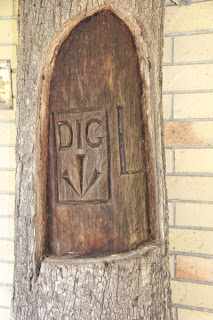Mines were prevalent the next day, too. Mine traffic was everywhere the further west we moved: trucks, utes and work vehicles are heavy on the suffering roads; and coal trains, often loaded with a hundred coal wagons, apiece, are busy riding the rails beside the road. We saw five massive rail shipments in just one morning. On tracks that are being renewed, and strengthened, we imagine.
Yet at Blackwater, which appeared to us virtually a purpose-built mine town, one of the local farmers from Dingo told us that the mining down turn is biting hard at the community. Added to which the drive-in-drive-out and FIFO mine worker philosophy utilised by the mines did little to benefit the town, he argued. Donga-type resorts were clustered in many parts of town, all serviced and efficient, and single men tended to stay in the area for their shift only; their families living elsewhere. So, schools, shops, and the community suffered under those sorts of pressures, he said.
Though I can’t say it looked as if it was doing it too tough to us, at the moment. We thought it busy and bustling; but then we don’t have the perspective of time to see the difference.
We stopped for a break in a little park in the village of Comet only to find that Ludwig Leichhardt had been here before us. In fact, he named the place after seeing a comet while here, on one of his trips in the 1840s. He also left a DIG tree, which really surprised us, as while we are familiar with the term ‘DIG tree’ we had heard it, previously, only in relation to Burke and Wills’s tragic expedition and had no idea that it was standard practice for early explorers to leave a cache of food and journals under a tree marked with the word: DIG. As Leichhardt did. Leichhardt’s original DIG sign is on a tree trunk cut and caged in wire, the etching so old it is barely visible. For clarity, we took a shot of what it would have looked like new.
Then we learned another amazing piece of Aussie history: Ludwig Leichhardt discovered coal around these parts.
We were left to wonder: had Leichhardt been able to look ahead nearly two hundred years, at the polluted waters around these shires, at the roads and rails creaking under the weight of digging out and transporting this black gold, at these strange donga-communities that have sprouted hereabouts, would he have made the effort to bend down and pick up that first piece of black coal, given what would eventuate?
We ended up chatting, very fortuitously, to an auto-electrician parked in a pullout in Emerald where we happened to be map reading. Luckily, he had his tools on tap, and after a question or three, he popped in to test our inverter and batteries and clarified much about our solar, inverter and batteries system that we did not understand. We now know what to do with some of the switches in our rig that we had no clue about before. A brilliant encounter.
We then hunted down a quite campground in the back of Emerald for the night, away from the trucks, trains and bustle of the town and, again, found fruit pickers from many countries and creeds. Mandarins are being picked at the moment, grapes in about three weeks, we were told. We were surprised as we had seen no such crops from the road. We were even offered guided visits to see the fruit plantations in action. The hospitality out here is amazing.
We were told by some of the staff that a group of the Tongan fruit-pickers here aim to save $10,000 AUD a year from each nine month contract, hoping to take that back home during their break period. A great goal, though it still means families living apart in order to survive.
 |
| Leichhardt left a dig sign much like this |
Great to see you blogging again, looking forward to your adventures...
ReplyDeleteEnjoying your blogs. And you also answered a question that I was wondering about: whether the Pacific worker scheme was still operating!
ReplyDelete